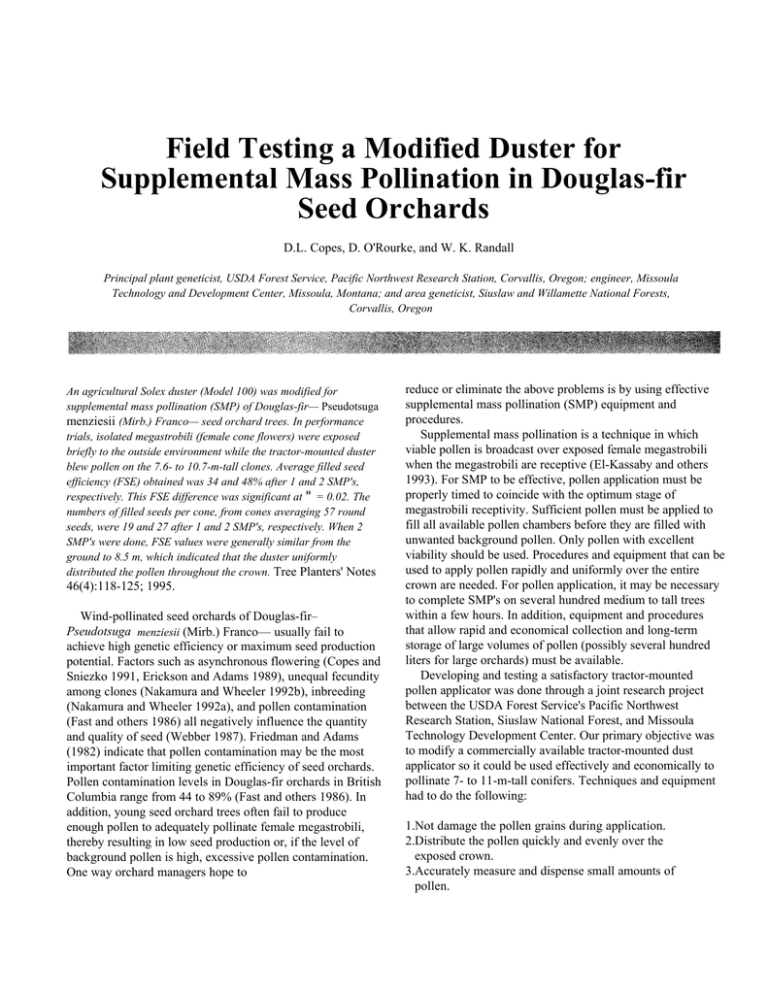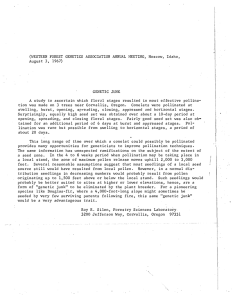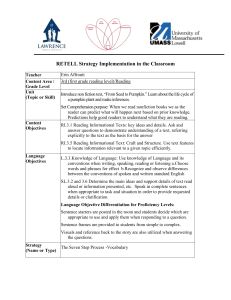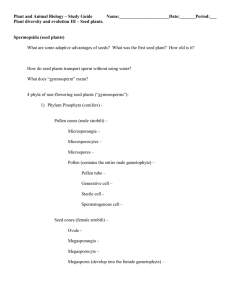Field Testing a Modified Duster for Supplemental Mass Pollination in Douglas-fir
advertisement

Field Testing a Modified Duster for Supplemental Mass Pollination in Douglas-fir Seed Orchards D.L. Copes, D. O'Rourke, and W. K. Randall Principal plant geneticist, USDA Forest Service, Pacific Northwest Research Station, Corvallis, Oregon; engineer, Missoula Technology and Development Center, Missoula, Montana; and area geneticist, Siuslaw and Willamette National Forests, Corvallis, Oregon An agricultural Solex duster (Model 100) was modified for supplemental mass pollination (SMP) of Douglas-fir— Pseudotsuga menziesii (Mirb.) Franco— seed orchard trees. In performance trials, isolated megastrobili (female cone flowers) were exposed briefly to the outside environment while the tractor-mounted duster blew pollen on the 7.6- to 10.7-m-tall clones. Average filled seed efficiency (FSE) obtained was 34 and 48% after 1 and 2 SMP's, respectively. This FSE difference was significant at " = 0.02. The numbers of filled seeds per cone, from cones averaging 57 round seeds, were 19 and 27 after 1 and 2 SMP's, respectively. When 2 SMP's were done, FSE values were generally similar from the ground to 8.5 m, which indicated that the duster uniformly distributed the pollen throughout the crown. Tree Planters' Notes 46(4):118-125; 1995. Wind-pollinated seed orchards of Douglas-fir– Pseudotsuga menziesii (Mirb.) Franco— usually fail to achieve high genetic efficiency or maximum seed production potential. Factors such as asynchronous flowering (Copes and Sniezko 1991, Erickson and Adams 1989), unequal fecundity among clones (Nakamura and Wheeler 1992b), inbreeding (Nakamura and Wheeler 1992a), and pollen contamination (Fast and others 1986) all negatively influence the quantity and quality of seed (Webber 1987). Friedman and Adams (1982) indicate that pollen contamination may be the most important factor limiting genetic efficiency of seed orchards. Pollen contamination levels in Douglas-fir orchards in British Columbia range from 44 to 89% (Fast and others 1986). In addition, young seed orchard trees often fail to produce enough pollen to adequately pollinate female megastrobili, thereby resulting in low seed production or, if the level of background pollen is high, excessive pollen contamination. One way orchard managers hope to reduce or eliminate the above problems is by using effective supplemental mass pollination (SMP) equipment and procedures. Supplemental mass pollination is a technique in which viable pollen is broadcast over exposed female megastrobili when the megastrobili are receptive (El-Kassaby and others 1993). For SMP to be effective, pollen application must be properly timed to coincide with the optimum stage of megastrobili receptivity. Sufficient pollen must be applied to fill all available pollen chambers before they are filled with unwanted background pollen. Only pollen with excellent viability should be used. Procedures and equipment that can be used to apply pollen rapidly and uniformly over the entire crown are needed. For pollen application, it may be necessary to complete SMP's on several hundred medium to tall trees within a few hours. In addition, equipment and procedures that allow rapid and economical collection and long-term storage of large volumes of pollen (possibly several hundred liters for large orchards) must be available. Developing and testing a satisfactory tractor-mounted pollen applicator was done through a joint research project between the USDA Forest Service's Pacific Northwest Research Station, Siuslaw National Forest, and Missoula Technology Development Center. Our primary objective was to modify a commercially available tractor-mounted dust applicator so it could be used effectively and economically to pollinate 7- to 11-m-tall conifers. Techniques and equipment had to do the following: 1.Not damage the pollen grains during application. 2.Distribute the pollen quickly and evenly over the exposed crown. 3.Accurately measure and dispense small amounts of pollen. 4.Be simple to operate so that one person could simultaneously drive the tractor and operate the pollen duster. 5.Be durable and reliable under field conditions so that equipment does not fail during critical pollina tion periods. Equipment Selection and Modification A Model 100 Solex duster was selected for modification and testing. The model had the following factory specifications: air flow, 82 m3/min (2,900 ft3/min); air velocity, 145 km/hr (90 miles/hr). Fifteen horsepower was required to power the equipment through a type I and II hitch attached to a 540-rev/min power takeoff outlet. The factory duster was designed primarily for applying pesticide dusts to vineyards. It directed the airflow from the outlet parallel to the ground rather than vertically, which is needed for pollinating tall trees. To correct that problem, the airflow was directed 60º upward by inserting a flange between the fan housing and the exit baffles (figure 1). Further adjustment of the airflow was done by manually adjusting the three horizontal deflector plates in the outlet housing. The chemical hopper and metering system were replaced with a 2­ liter pollen hopper and a more accurate pollen-metering system (figure 2). Metering of pollen was done at the base of the pollen hopper with a rotating rod that contained the metering chamber. A small electric motor-driven rod rotated one revolution each time the remote control was activated and released a prescribed volume of pollen into the airstream. Technical drawings of all equipment modifications can be obtained from the USDA Forest Service, Missoula Technology and Development Center, Building 1, Fort Missoula, Missoula, MT 59801. Field-Testing Methods Final field tests of the modified duster were made in April 1993 on 7.6- to 10.7-m-tall grafted trees near Monmouth, Oregon. To ensure that only the effect of pollen from SMP was measured, we covered branch tips bearing female megastrobili with kraft pollination bags before the reproductive buds opened. All male buds were removed from the isolated areas of branches of 5 clones (trees used as females). Twenty isolation bags were placed over megastrobili on each tree. All the bags were located on the same side of each tree so that every megastrobilus could be pollinated with a single pass of the duster. The isolation bags were positioned throughout the crown so the effectiveness of the duster to distribute pollen uniformly could be determined. The 145-km/hr (90-mi/hr) airstream of the Solex duster was used immediately preceding each SMP to remove previously shed pollen grains from each tree. Immediately after that "cleaning," the 20 isolation bags were removed and SMP was done. Five to ten minutes per tree were required to complete the removal of the 20 SMP isolation bags, complete the SMP treatment, and position the isolation bags over the megastrobili. A total of 100 ml (62 g) of pollen was released into the airstream in 5 or 6 increments of 20 or 16.7 ml, respectively. Ground speed of the tractor during pollination ranged from 3.2 to 4.8 km/hr (2 to 3 miles/hr). Pollination of each half-crown took about 4 sec. Half of the isolation bags were given a second SMP treatment with an additional 100 ml of pollen 1 day (clones 185-17 and 167-8), 2 days (clones 195­ 16 and 129-10), or 3 days (clone 207-11) after the first SMP Pollen used for SMP was collected in 1992 using vacuum techniques and equipment described by Copes and other (1991) and stored at -135 ºC. In vitro germination tests of pollens were done shortly before SMP Pollen germination averaged greater than 90% viability. Viability was determined by using the 10P10B in vitro solution [10%Brewbaker solution and 10% polyethylene glycol (mw 4000)] described by Webber and Bonnet-Masimbert 1993). The pollen was rehydrated before in vitro testing, but not before SMP. Mature, unopened cones were collected from each clone in August 1993 when the cones began to turn brown. Five healthy cones were selected from each bag, and each cone was placed in a separate container so the seeds from individual cones could be evaluated. The average number of seeds per cone from each isolation bag was the experimental treatment for the test. All round seeds (RS) were extracted from each cone by tearing each cone apart by hand, counting the number of RS per cone (RSC), and making X ray images of all RS to identify the number of filled seeds per cone (FSC). Flat seeds were excluded from the total seed count of each cone and from the calculations of filled seed efficiency (FSE) because they were not viable at pollination. FSE was calculated by dividing the number of FSC by the number of RSC and multiplying the quotient by 100. Transformation of data before analysis of variance (ANOVA) was not necessary when the most frost-damaged clone (167-8) was excluded from analysis. Analysis of variance of 1 and 2 SMP treatments revealed different linear slopes for each treatment, making covariance analysis inappropriate. Instead, regression procedures for each SMP were used to investigate the linear relation between FSE and megastrobili height aboveground (SAS 1993). Significance was judged achieved when " = 0.05. Clone selection was random and type III mean squares were used. Results and Discussion A damaging -5.5 °C (22 °F) frost occurred the night before the first SMP treatments on April 12, 1993. Damage from earlier frosts may have contributed to a reduction in the number of round seeds per cone and in lower FSE of both SMP and control pollinated cones. Severity of damage, as evidenced by variation in RS and FSE, differed among clones (tables 1 and 2). The RSC for the clones tested averaged about 60 (range, 50 to 65) of the 80 potential fertile ovule positions (Copes 1985). Results suggest there was a wide range in susceptibility of megastrobili to frost damage. Seed data from clone 167-8 were of questionable value in evaluating duster efficiency because the megastrobili of that clone had been severely damaged, as evidenced by the low number of RSC and unusually low fecundity. Clonal effects in ANOVAs for FSE were not significant when clone 167-8 data were excluded. A single SNIP resulted in 34% FSE and a second SMP made 1, 2, or 3 days later improved FSE to 48% (table 1). This 14% FSE difference was significant (" = 0.02). Our present study supports the additive effect of a second SMP on FSE reported by El-Kassaby and others (1993). Test results indicate the maximum FSE possible under the 1993 test conditions. Our primary objective was simply to determine the maximum effectiveness of the modified machine. To obtain that information, the masking effects of contaminating pollen were reduced or eliminated by keeping the megastrobili isolated except when the SMP treatments were being done. Maximum FSE occurred with clone 195-16 (tables 1 and 2). The 56% FSE for clone 195-16 megastrobili approached the lower range achieved by conventional control-pollinations when megastrobili were saturated with pollen (Copes 1985). The study FSE averages of 34 and 48% FSE from 1 and 2 SMP's, respectively were greater than the 29% FSE average found in 4 wind-pollinated coastal Douglas-fir orchards (McAuley 1990). The average of 27 FSC (table 1) after 2 SMP's was larger than the 21 FSC reported in 4 orchards (McAuley 1990) and was comparable to 27 to 31 FSC from SMP and windpollinated cones from another orchard (ElKassaby and others 1993). Two SNIP treatments in the present study produced clonal averages that ranged from 21 to 33 FSC (table 1). Uniformity of FSE values among bags within clones after 2 SMP's indicated the duster uniformly delivered pollen as high as 8.5 m (table 2). A significant negative linear relation ("= 0.02) for average FSE and megastrobili height (bag height) existed after 1 SMP. That relation was not evident after 2 SMP's (table 2). On a clonal basis, significant negative-linear relations between FSE and isolation-bag height were detected for clones 207-11 and 185-17 after 1 SMP and for clone 185-17 after 2 SMP's. The general relation of FSE and number of SMPs is shown in figure 3 for data subjected to a 70% spline-smoothing procedure. Table 1- Results from 1 or 2 supplemental mass pollinations (SMP) applications (100 ml of pollen/application) on number of round (RSC) and filled seeds per cone (FSC) and filled seed efficien cy (FSE)* 1 SMP Clone Mean bag height (m) RSC (no.) 2 SMP's Mean FSC FSE (no,) (%) Mean bag height (m) RSC (no.) FSC (no,) FSE (%) 47 207-11 6.4 72 16 22 6.4 72 33 195-16 7.6 58 24 42 7.3 56 31 56 129-10 6.7 53 19 37 5.8 50 24 50 185-17 7.3 46 17 36 7.3 51 21 42 167-8† 5.8 42 04 10 5.8 40 07 17 Mean 6.7 54 16 29 6.4 54 23 42 7.0 57 19 34‡ 6.7 57 27 48‡ Mean without * Filled seed efficiency was calculated by dividing the number of filled seeds by the number of round seeds per cone and multiplying the quotient by 100. † Most Beverly frost damaged clone. ‡ Average FSE difference of cones that received 1 or 2 SMP's was significant (P=0.02). Table 2-Filled seed efficiencies (FSE) after 1 or 2 SMP applications and number of isolation bags located between 2.7 and 9.7 m aboveground FSE* Bag ht. (m) 9.7 9.4 9.1 8.8 8.5 8.2 7.9 7.6 7.3 7.0 6.7 6.4 6.1 5.8 5.5 5.2 4.9 4.6 4.3 4.0 3.6 3.3 3.0 2.7 0.0 Mean P>t ‡ 207-11 1 2 12 30 195-16 1 39 39 34 23 11 129-10 2 1 45 50 18 26 47 54 54 46 19 62 62 50 21 08 29 38 25 2 49 56 60 56 50 21 30 31 24 34 37 2 1 19 05 09 36 33 49 19 48 09 24 53 61 32 19 50 48 38 69 61 50 06 13 54 22 .05 17 11 36 47 .95 07 15 19 29 19 33 56 28 2 50 51 26 1 167-8† 64 32 65 55 22 41 185-17 42 .21 56 .09 48 53 37 .06 50 .45 36 .00 42 .02 10 .10 1 .6 Average FSE/no. of bags All clones All clones exc. 167-8 1 39/1 15/2 22/2 27/3 33/3 22/2 35/2 19/1 33/2 34/3 38/1 27/4 35/2 38/1 26/3 37/2 26/1 56/1 54/1 17/1 20/2 2 38/2 35/2 32/2 36/1 44/2 43/3 63/2 49/2 52/3 35/2 56/3 46/2 07/1 51 /2 15/1 40/4 29/1 19/1 1 2 39/1 15/2 38/2 39/1 35/2 27/3 54/1 33/3 36/1 22/2 44/2 35/2 56/2 19/1 63/2 33/2 49/2 51 /2 9/1 52/3 27/4 50/1 35/2 56/3 38/1 37/2 61 / 1 51 /2 26/1 56/1 54/1 47/3 36/1 28/1 48/1 53/1 48/1 53/1 29 NS 42 NS 34 02 48 .43 NS = no statistical test was done. * FSE was calculated by dividing the number of filled seeds per cone by the number of round seeds per cone and multiplying the quotient by 100. †Most frost-damaged clone. ‡ Probability of obtaining a larger value of t by chance for the negative linear relation between FSE and height of megastrobili aboveground. The airstream outlet was large enough and properly oriented to pollinate all visible areas of the crowns as the duster moved past each tree. The effectiveness of the duster above 9.4 m could not be determined because of insufficient bags above that height. The machine appeared to move the pollen highest in the trees when the ground speed was slowest. Fast movement of the tractor and duster may create a horizontal wind-speed vector that reduces vertical wind speed, thereby decreasing the effective dusting height. Variation in FSE and RSC among megastrobili located within isolation bags was detected. Such variation may result from the megastrobili receiving different amounts of SMP due to wind drift, poor megastrobili location in the crown in relation to the position of the duster, or simply because some megastrobili may not be receptive when SMP is done. Two SMP applications removed much of the among-bag variation in FSE (table 2). Individual megastrobili of a clone do not all become receptive the same day (Owens and Simpson 1982). During warm springs in western Oregon, it is common for 80 or 90% of the megastrobili on individual trees to open within 3 days of the opening of the first megastrobilus bud (personal observation). Similarly, individual trees in British Columbia complete shedding pollen some years in 3 to 5 days (Ebell and Schmidt 1964). Cool, wet weather occurring after opening of the earliest megastrobilus buds may delay opening of unopened buds by a week or more. Combinations of cool, wet weather prior to bud opening and warm, dry weather at the start of megastrobili bud opening often result in a short breeding seasons (Copes and Sniezko 1991, Fashler and El-Kassaby 1987). Conditions that promote rapid and uniform megastrobilus opening enhance SMP success and lower costs by reducing the number of pollinations needed. The second SMP applications were done 1, 2, or 3 days after the first SMP's for clones 185-17 and 167-8, 195-16 and 129-10, and 207-11, respectively. An average of 6 to 8% increase in FSE occurred for each day the second SMP was delayed (table 2). The statistical significance of this could not be tested due to lack of replication. Increased FSE may have occurred because additional megastrobili had become receptive following the first SMP. Owens and Simpson (1982) and Webber (1987) both report that Douglas-fir megastrobili remain highly receptive for 6 days following bud opening. ElKassaby and others (1993) report FSE increases after 2 SMP applications, but with little increase from additional SMP Effective SMP procedures must ensure that receptive megastrobili are pollinated before they receive significant amounts of contaminating pollen. Unwanted pollen fills pollen chambers and physically prevents late-arriving SMP pollens from being taken into the pollen chambers (Webber and Yeh 1987). In Douglas-fir, an average of 3 to 4 pollen grains/pollen chamber is common (Owens and others 1991). The significant within-clone variation in megastrobili development (Owens and Simpson 1982) will necessitate several SMP's on each tree. Timing of applications is important, as Webber and Yeh (1987) indicate that pollen arriving 6 hours after earlier pollination is less likely to be taken into the pollen chambers. We suggest an operational SMP program in which pollen is applied to each receptive tree in early morning of the day following first megastrobilus bud opening. The first SMP should be followed with a second early morning SMP on day 2 or 3, and possibly with a third SMP on days 3, 4, or 5. Pollinating in early morning is important because little pollen is usually shed during the night or early morning hours when the relative humidity is high and the wind speed is low. Warm, dry and cool, wet weather can increase or decrease the effective length of the pollination period, respectively (Copes and Sniezko 1991). The actual SMP schedule each year must be based upon floral phenology of the clones in that particular year. The "first come, first in" pollination mechanism in Douglas-fir (Webber and Yeh 1987) appears to lend itself to SMP manipulation. Technology exists for rapid and costefficient vacuum collection and long-term storage of the quantities of Douglas-fir pollen needed for the SMP of hundreds of large trees (Copes 1987, Copes and others 1991, Webber 1987). Our modification of the factory duster was necessary so that the machine could accurately and uniformly dispense precise volumes of viable pollen. Pollinations can be accomplished rapidly and efficiently with just 1 tractor operator. Operational SMP will never succeed in excluding all unwanted pollen, but we believe that a meaningful reduction will occur if proper SMP procedures and equipment are used. We hope for additional gains in the future as we obtain more accurate knowledge of amount of pollen needed, the number of SMP's, and the optimum timing of SMP applications. Address correspondence to: Dr. Donald L. Copes, Pacific Northwest Research Station, Forestry Sciences Laboratory, 3200 Jefferson Way, Corvallis, OR 97331. Literature Cited Copes DL. 1985. Fertility of Douglas-fir pollen after one year of storage in liquid nitrogen. Forest Science 31:569-574. Copes DL. 1987. Long-term storage of Douglas-fir pollens. Forest Science 33:244-246. Copes DL, Sniezko RA. 1991. The influence of floral bud phenology on the potential mating system of a wind-pollinated Douglas-fir orchard. Canadian Journal of Forest Research 21:813-820. Copes DL, Vance NC, Randall WK, Jasumback A, Hallman R. 1991. Vacuum collection of Douglas-fir pollen for supplemental mass pollinations. Res. Note PNW-RN503. Portland, OR: USDA, Forest Service, Pacific Northwest Research Station. 8 p. Ebell LF, Schmidt RL. 1964. Meteorological factors affecting conifer pollen dispersal on Vancouver Island. Publ. 1036 Canadian Department Forestry. 28 p. El-Kassaby YA, Barnes S, Cook C, MacLeod DA. 1993. Supplemental mass pollination success rate in a mature Douglas-fir seed orchard. Canadian Journal of Forest Research 23:1096-1099. Erickson Vi, Adams WT. 1989. Mating success in a coastal Douglasfir seed orchard as affected by distance and floral phenology. Canadian Journal of Forest Research 19:1248-1255. Fashler AM, El Kassaby YA. 1987. The effect of water spray cooling treatment on reproductive phenology in a Douglas-fir seed orchard. Silvae Genetlca 36:245249. Fast W, Dancik BP, Bower RC. 1986. Mating system and pollen contamination in a Douglas-fir clone bank. Canadian Journal of Forest Research 16:1314­ 1319. Friedman ST, Adams WT. 1982. Genetic efficiency in loblolly pine seed orchards. Proceedings of the Southern Forest Tree Improvement Conference 16:213-220. McAuley L. 1990. Coastal Douglas-fir cone analysis results. Internal Rep. 8653K. Victoria, BC: British Columbia Ministry of Forests, Silviculture Branch. Nakamura RR, Wheeler NC. 1992a. Pollen competition and parental success in Douglas-fir. Evolution 46:846-851. Nakamura RR, Wheeler NC. 1992b. Self-fertility variation and parental success through outcrossing in Douglas-fir. Theoretical and Applied Genetics 83:851-854. Owens IN, Colangeli AM, Morris SJ. 1997. Factors affecting seed set in Douglas-fir. Canadian Journal of Botany 69:229-238. Owens IN, Simpson SJ. 1982. Further observations on the pollination mechanism and seed production of Douglas-fir. Canadian Journal of Forest Research 12:431-434. SAS. 1993. SAS/STAT user's guide, version 6, 4th ed. Cary, NC: Statistical Analysis Systems, Institute, Inc. Webber JE. 1987. Increasing seed yield and genetic efficiency in Douglasfir seed orchards through pollen management. Forest Ecology and Management 19:209-218. Webber JE, Bonnet-Masimbert J. 1993. The response of dehydrated Douglasfir (Pseudotsuga menziesii) pollen to the in vitro viability assays and their relationship to the actual fertility. Annals of Scientific Forestry 50:1-22. Webber JE, Yeh JCH. 1987. Test of the first-on, first-in pollination hypothesis in coastal Douglas-fir. Canadian Journal of Forest Research 17:63-68.




